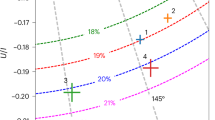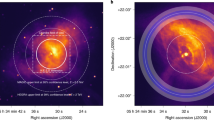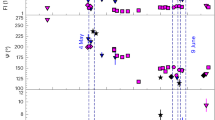Abstract
RECENTLY Rees and Gunn1 suggested that the 30-Hz wave power probably emerging from the Crab Nebula Pulsar NP0532 does not propagate further than a small region around the pulsar with a radius of about 10% of the nebular radius. Beyond this, in the main body of the nebula, the magnetic field is built up in toroidal form to equipartition strength so that the continuum emission from the bulk of the nebula is entirely synchrotron radiation. The axis of this toroid is aligned with the rotational axis of the pulsar which is assumed to be lying in the plane of the sky along the major axis of the nebula (NW/SE). A test of this proposal is the measurement of a characteristic sign change in the distribution of Faraday rotation or circular polarisation over the nebula. If the nebula is divided into quadrants along its major and minor axes, then adjacent quadrants should have the opposite sign and opposite quadrants the same sign. Since any measured Faraday rotation does not necessarily arise within the body of the nebula, the critical test becomes a detection of the characteristic sign distribution in the small amount of circular polarisation (∼0.1 %) expected at radio frequencies from ordinary synchrotron radiation2. The theoretical frequency dependence of ν−1/2 for the fraction of circular polarisation would then explain the null result of Landstreet and Angel3 (see also ref. 4) at optical frequencies. Here I report a measurement of the distribution of circular polarisation (Stokes parameter V) in the Crab Nebula at 1,415 MHz obtained during a series of high accuracy full polarisation measurements with the Westerbork Synthesis Radio Telescope in November 1971.
This is a preview of subscription content, access via your institution
Access options
Subscribe to this journal
Receive 51 print issues and online access
$199.00 per year
only $3.90 per issue
Buy this article
- Purchase on Springer Link
- Instant access to full article PDF
Prices may be subject to local taxes which are calculated during checkout
Similar content being viewed by others
References
Rees, M. J., and Gunn, J. E., Mon. Not. R. astr. Soc., 167, 1 (1974).
Legg, M. P. C., and Westfold, K. C., Astrophys. J., 154, 499 (1968).
Landstreet, J. D., and Angel, J. R. P., Nature, 230, 103 (1971).
Martin, P. G., Illing, R., and Angel, J. R. P., Mon. Not. R. astr. Soc., 159, 191 (1972).
Weiler, K. W., Astr. Astrophys., 26, 403 (1973).
Conway, R. G., Gilbert, J. A., Raimond, E., and Weiler, K. W., Mon. Not. R. astr. Soc., 152, 1p (1971).
Berge, G. L., and Seielstad, G. A., Astr. J., 77, 810 (1972).
Duin, R. M., and Laan, H. van der, Astrophys. Lett., 12, 177 (1972).
Weiler, K. W., and Seielstad, G. A., Astr. Astrophys., 21, 393 (1972).
Seielstad, G. A., and Weiler, K. W., Astrophys. J., 154, 817 (1968).
Ekers, R. D., Allen, R. J., and Luyten, J. R., Astr. Astrophys., 27, 77 (1973).
Author information
Authors and Affiliations
Rights and permissions
About this article
Cite this article
WEILER, K. Measurement of circular polarisation in the Crab Nebula at 1,415 MHz. Nature 253, 24–25 (1975). https://doi.org/10.1038/253024a0
Received:
Issue Date:
DOI: https://doi.org/10.1038/253024a0
Comments
By submitting a comment you agree to abide by our Terms and Community Guidelines. If you find something abusive or that does not comply with our terms or guidelines please flag it as inappropriate.



